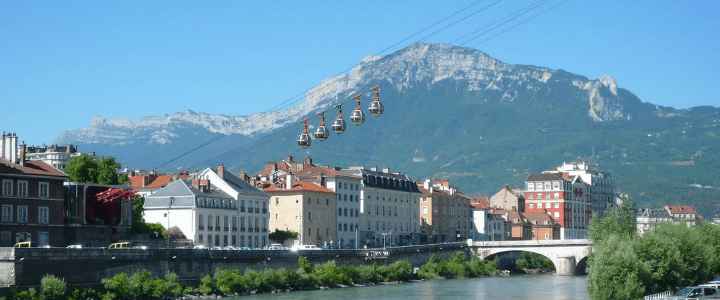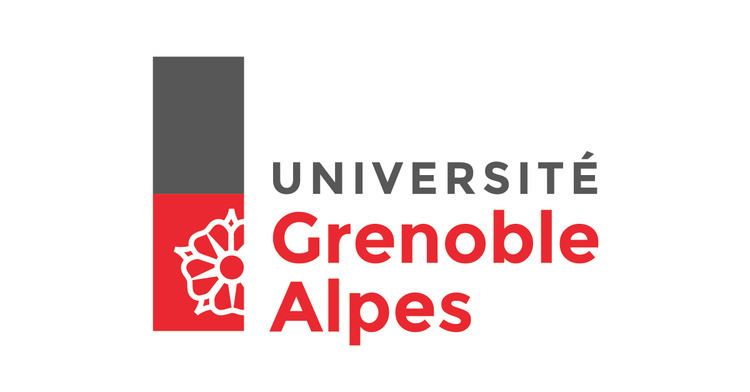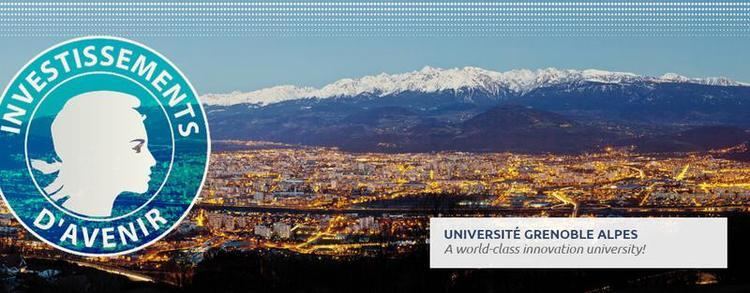Budget €450 million Academic staff 3,000 Number of students 45,000 | Established 1339 (1339) President Lise Dumasy Founded 1 January 2016 | |
 | ||
Motto in English Truth shall set you free Motto Veritas Liberabit (la, Truth shall set you free) Notable alumni Similar Joseph Fourier University, Pierre Mendès‑France University, Stendhal University, University of Savoy, Grenoble Institute of Political S | ||
Grenoble Alpes University (UGA, French: Université Grenoble Alpes) is a public university in Grenoble, France. It is the third largest university in France with about 45,000 students and over 3,000 researchers.
Contents
- Early history 13391800
- Modern era 18001968
- Recent history 1968present
- Academics
- Notable people
- Politics
- Mathematics and sciences
- References

Founded in 1339 as University of Grenoble, it was split in 1970s following changes in French politics, only to be reunited again in 2016 under the name Grenoble Alpes University.

UGA is traditionally known for its research and education in the natural science and engineering, but also law, linguistics, and psychology. It is often cited among the best and most innovative universities in Europe.

The university is organized around two closely located urban campuses: Domaine Universitaire of 175 ha in Saint-Martin-d'Hères and Campus GIANT of 250 ha in Grenoble. UGA also owns and operates facilities in Valence, Chambéry, Les Houches, Villar-d'Arêne, Mirabel, Échirolles, La Tronche and Gières.
Grenoble is one of the biggest scientific centers of Europe. It hosts facilities of every existing public research institution in France. This allows UGA to have hundreds of research and teaching partnerships, including close collaboration with the French National Centre for Scientific Research (CNRS) and the French Alternative Energies and Atomic Energy Commission (CEA). Overall, Grenoble as a city is the largest research center in France after Paris with 22,800 researchers.
Grenoble is also renowned for the excellence of its academic research in humanities and political sciences. University Grenoble Alpes, alongside public scientific institutions, hosts some of the largest research centers in France in fields such as political science, urban planning or the sociology of organizations.

Early history (1339–1800)
Grenoble Alpes University was founded in May 12, 1339 by Humbert II of Viennois, the last independent ruler of Dauphiné (state of the Holy Roman Empire), to teach civil and canon law, medicine, and the liberal arts. It was considered as a leader in the Renaissance revival of the classics and development of liberal arts.
Humbert's actions were inspired by his granduncle Robert, King of Naples, at whose royal court Humbert spent his youth. King Robert, known as the Wise, skilfully developed Naples from a small port to a lavish city and had a reputation of a cultured man and a generous patron of the arts, friends with such great minds as Petrarch, Boccaccio, and Giotto.
Such rich experience contributed to Humbert's intention to create a university in his own state, and to do so he visited Pope Benedict XII to get a papal bull of approval.
Humbert cared deeply about his students, offering generous aid, protection, and even providing a hundred of them with free housing. Humbert's financial losses during the Smyrniote crusades, Black Death, and Dauphiné's attachment to France have greatly decreased the activity of the university leading to its closure, since a small mountainous town couldn't support its activity on its own.
It was reopened again by Louis XI of France in 1475 in Valence under the name University of Valence, while the original university was restored in Grenoble in 1542 by Francis de Bourbon, Count of St. Pol. The two universities were finally reunited in 1565. At that point Grenoble was an important center of law practice in France, thus law practice was at the center of the university education.
The French Revolution, with its focus on the end to inherited privilege, led to the suppression of most universities in France. To revolutionaries, universities embodied bastions of corporatism and established interests. Moreover, lands owned by the universities and utilized for their support represented a source of wealth and therefore were confiscated, just as property possessed by the Church.
Modern era (1800–1968)
In 1805–1808, Napoleon reestablished faculties of law, letters, and science. Bourbon Restoration had temporarily suppressed the Faculty of Letters and the Faculty of Law, but starting 1850s the activity of the university was rapidly developing again
The development of the sciences at the university was spearheaded by the transformation of Grenoble from a regional center to a major supplier of industrial motors and electrical equipment in 1880s. The faculties were formally inaugurated as the University of Grenoble in 1879 in the newly constructed Place de Verdun. There were around 3000 students in 1930.
Recent history (1968–present)
Following riots among university students in May 1968, a reform of French education occurred. The Orientation Act (Loi d’Orientation de l’Enseignement Superieur) of 1968 divided the old faculties into smaller subject departments, decreased the power of the Ministry of Education, and created smaller universities, with strengthened administrations.
Thus, sharing the fate of all French universities in 1970s, University of Grenoble was split into four institutions. Each university had different areas of concentration of study and the faculties were divided as follows:
On 1 January 2016, the first three institutions reunited to restore the original common institution under the name Grenoble Alpes University. Although Grenoble-INP remains apart, it is an active member of the community Grenoble Alpes University and cooperates very closely with the university not only in research projects, but also by sharing labs, offering mutual courses and trainings for students and researchers etc.
Academics
Grenoble Alpes University covers all disciplinary fields and is made up of 24 teaching departments, schools and institutes as well as 106 research departments, all spread out in six centers bringing together different types of organisations (joint research departments, host teams, platforms) in the same scientific field.
24 teaching departments are:
In addition, there is Grenoble Institute of Political Studies - an autonomous institute of the Grenoble Alpes University, focusing on rigorous training of students in political sciences.
Notable people
Throughout its history, a considerable number of Grenoble Alpes University alumni have become notable in different fields, ranging from academics to political leaders, executives, and artists.
Politics
Many European politicians have studied law, economics, and languages in UGA, including: Reinhold Maier; Helene Weber;Walther Schreiber; Michel Destot; Louis Besson;Thierry Repentin; André Vallini; and Geoffrey Acland.
Other political leaders include: Gaétan Barrette, Minister of Health and Social Services of Canada; Paul Kaba Thieba, Prime Minister of Burkina Faso; Abderrahmane Benkhalfa, Minister of Finance of Algeria; Hazem El Beblawi, Prime Minister of Egypt; Richard E. Hoagland, US Ambassador; Abdoulaye Wade, President of Senegal; Driss Basri, Interior Minister of Morocco; Ahmedou Ould-Abdallah, Ambassador for Mauritania; Şenkal Atasagun, Chief of the National Intelligence Organization of Turkey; Ignas Jonynas, Lithuanian diplomat; Souvanna Phouma, Prime Minister of Laos; Ali Al Shami, Minister of Foreign Affairs of Lebanon; Fathallah Sijilmassi, Moroccan politician and economist; Mohammed al-Dairi Minister of Foreign Affairs of Libya.
UGA alumni also include American journalist Warren D. Leary, French journalists Éric Conan, Olivier Galzi, Françoise Joly, Laurent Mauduit, Philippe Robinet, Caroline Roux, British Joanna Gosling and Safia Shah, and German Jona von Ustinov, who worked for MI5 during the time of the Nazi regime.
Among social activists who attended UGA, one could find Léo-Paul Lauzon, Léa Roback , Austin Mardon, and the former CEO of the Chicago Urban League James Compton.
Mathematics and sciences
Numerous prominent scientists have studied at the Grenoble Alpes University since the development of the hydro-power in the region in 1880s. Prominent fields include physics, material sciences, and computer sciences with alumni like Yves Bréchet, member of the French Academy of Sciences; Rajaâ Cherkaoui El Moursli, who worked on the Higgs Boson discovery; Patrick Cousot, French computer scientist; Joseph Sifakis, Turing Award laureate; Claude Boutron, French glaciologist; Jean-Louis Coatrieux, French researcher in medical imaging; Michel Cosnard, French computer scientist; Paul Trendelenburg, German pharmacologist; Yousef Saad, computer scientist; Maurice Nivat, Catherine Ritz, French Antarctic researcher; Eric Goles, Chilean mathematician; René Alphonse Higonnet, French engineer; Marlon Dumas, Honduran computer scientist; Claire Berger, French physicist.
